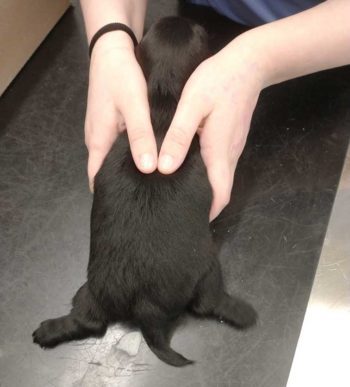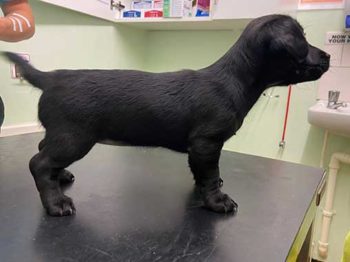31 Aug 2022
Alexander Bartlett BA, VetMB, MRCVS and Lauren Walker BSc(Hons) recount the case of a 23-day-old female Jack Russell terrier-poodle cross puppy that presented due to being unable to weight bear on her splayed hindlimbs

Shackling of the hindlimbs.
A 23-day-old female Jack Russell terrier-poodle cross puppy was presented due to being unable to weight bear on her hindlimbs, which were splayed laterally. Her gait consisted of a paddling movement, with an apparent inability for adduction, and her forelimbs appeared unaffected.
In contrast, the puppy’s two littermates were weight bearing on all four limbs, with correct ambulation consistent with their age and development.
Excluding the abnormal gait, her physical exam did not reveal any other abnormalities; no dorsoventral flattening of the thorax, no orthopaedic abnormalities and her withdrawal reflexes were present on the hindlimbs.

A complete investigation would have included radiographs to assess for dorsoventral flattening of the thorax and orthopaedic abnormalities of the pelvis and hindlimbs; however, due to a normal physical exam and client wishes, these were not completed in this case. Therefore, she was diagnosed with “swimmers syndrome”.
Relatively little literature exists concerning this syndrome, which mainly consists of individual case studies or small cohorts. Currently, the aetiology is unknown; however, proposed aetiologies include orthopaedic, nutritional, neurological, genetic and environmental factors (Nganvongpanit and Yano, 2013; Tomihari et al, 2022).
Recommended treatments within the literature vary in the intensity of interventions with some proposing solely physiotherapy (Kim et al, 2013), while others advocate complete immobilisation of the limbs for up to four weeks (Karcher et al, 2018).
Due to concerns regarding the practical application of and distress caused by complete immobilisation, a moderate approach consisting of shackling and physiotherapy of the hindlimbs was used.
Case studies have suggested that “shackling” or “hobbling” alongside physical massage of the affected limbs aids full recovery (Verhoeven et al, 2006; Gomes et al, 2015).
Massage, range of motion and supported walking exercises were introduced from initial presentation three times daily while the hobbles were worn.
The literature also suggests gentle compression and release of the lateral thorax to combat dorsoventral flattening (Kim et al, 2013), which was not done in this case.
Bandages were applied below the hock as per the previous research. Three types of bandages were used:

Microporous hypoallergenic tapes were stated by literature to be successful (Karcher et al, 2018). For eight days, we re-bandaged the legs every two to three days. Eight days after presentation, no more bandaging was done.
Serial assessments revealed significant improvements in the puppy’s gait. After six days she was able to weight bear and walk unsupported for short periods on non-slip surfaces; however, she would still collapse with splayed hindlimbs. After 10 days, she was able to adduct and walk unaided, with occasional collapse especially on slippery surfaces.
Three weeks after her initial presentation, she was almost indistinguishable from her littermates. The whole litter was presented for first vaccinations at eight weeks old and, although the swimmers puppy was the smallest of the litter, her gait was almost identical to the rest of the litter. She still occasionally had mild adduction and external rotation of the hindlimbs, although this was also noted in the other puppies on the slippery surface.
This case study suggests a good outcome is achievable with minimal immobilisation of the hindlimbs. Further research would be required to assess the contribution of immobilisation and physiotherapy, and how this is affected by the severity of the presentation.
We expect a good long-term prognosis.